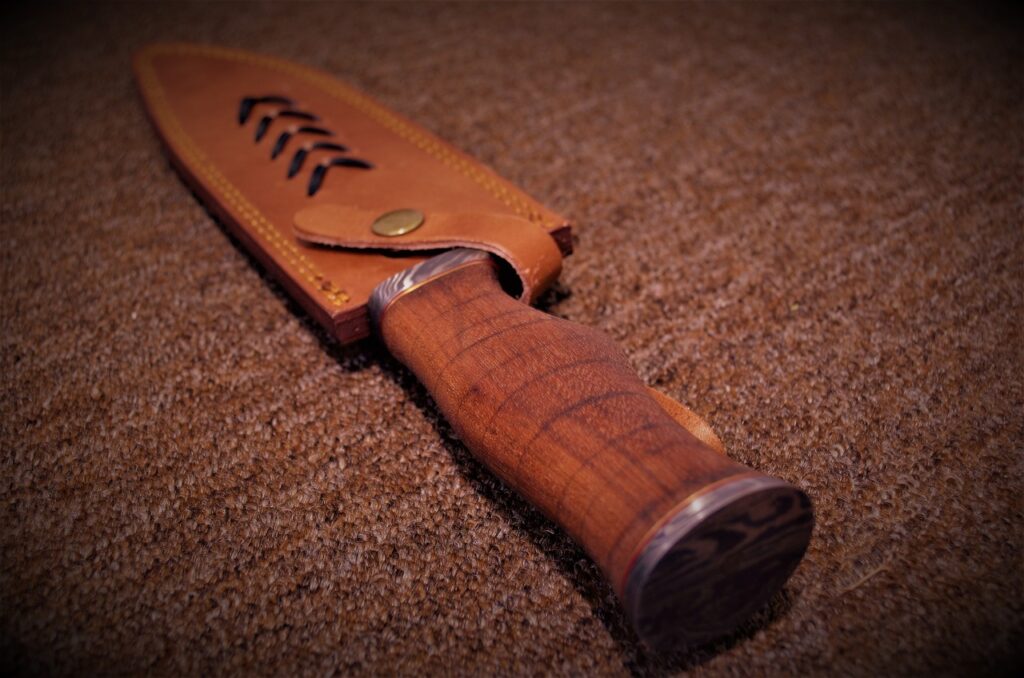What is a Damascus knife?
A Damascus knife is a blade made of a material called Damascus. The Damascus knife is a Damascus steel-bladed knife. It comes from India, where it was primarily used for military reasons in ancient times. Buying a Damascus knife for cooking is, nevertheless, the current vogue. Before I explain why it’s vital to realize that the term “Damascus” is used to describe a knife’s blade-style exclusively, and it doesn’t include any other information. It’s used for a range of duties, the most popular of which are cooking and hunting, due to its qualities and the sorts of steel it’s constructed of.

A Damascus knife’s blade is made up of numerous layers of steel of varying grades, which gives it a certain amount of endurance. Impurities are sometimes added to these steel layers to make them more flexible and hence less likely to shatter. The design, which includes round, sinuous, and spotted designs imprinted on its surfaces, is what sets it apart. Damascus knives come in a variety of styles, but not all of them are acceptable for use in the kitchen. Only Damascus Professional Kitchen Knife and Japanese Damascus Knife are available.
Variety of Damascus Knives
Damascus steel comes in a variety of forms and patterns, allowing for endless options when it comes to making one-of-a-kind blades. The look of the material is influenced by a variety of elements. Because these contributing elements are not always the same in the manufacturing of a traditionally crafted blade, a wide range of Damascus blades is available. It’s natural that the knife’s uniqueness isn’t relevant to everyone. The Damascus blade’s individuality, on the other hand, has secured its renown, fame, and long-term appeal.
Variations in Damascus Knives These Days

Damascus knives come in a variety of shapes and sizes. Damascus steel blades have practically infinite potential and distinctive blade variants. As a result, there are a plethora of diverse influencing elements that have an impact on the material’s look and always make it unique. These precise impacting elements are not always the same when creating a conventional blade. As a result, there are many distinct Damascus knife blades available. Of course, not everyone is concerned with the knife blade’s originality. From a historical standpoint, however, the Damascus blade’s individuality ensures its widespread popularity, renown, and continuing appeal.
How to recognize a real Damascus knife?
Damascus knife is a popular choice, and you may get amazing deals on it. This, of course, draws low-cost suppliers. However, in most situations, just the material’s nice look is duplicated. Waves or twist patterns are visually represented. Damascus steel has nothing to do with it. Regrettably, this is typically only realized after the fact. After a while, the soles will fall out. When grinding or polishing the blade, go even quicker.
Real Damascus steel may also be touched in most circumstances. The material transitions include a few minor anomalies. The layers on the back of the knife may also be seen if you look closely. With the finely polished blades, though, it’s impossible to see or hear.
How To Sharpen The Damascus Knife

Unfortunately, there are just a few good sharpeners you can put your faith in with your knife. You should absolutely take care of the sharpening issue as the owner of such a jewel. A whetstone is the finest way to sharpen a Damascus knife. A stone with a grain of 1000 and 3000+ is excellent for this use. A ceramic sharpening rod can also be used to keep the knife sharp. It must be used on a regular basis to achieve this (before starting work). See our knife sharpening page for additional details.
What length of the blade in cm should a Damascus knife have?
The smallest Damascus knives tested have 9cm long blades, while the longest blades are about 20cm long. There are also knives with a blade length of 25 cm, but they are quite unusual for home use. However, the length of the blade in cm says nothing about the hardness and sharpness, that is, the cutting properties.

